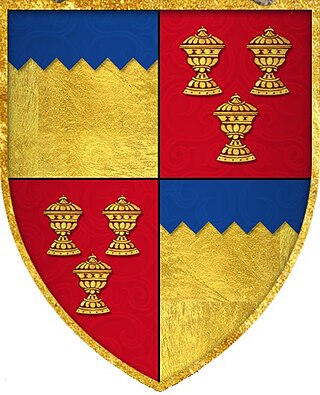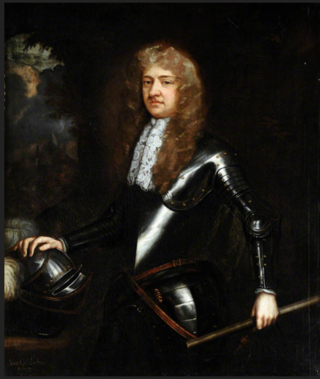
Piers Butler, 8th Earl of Ormond, 1st Earl of Ossory also known as Red Piers, was from the Polestown branch of the Butler family of Ireland. In the succession crisis at the death of Thomas Butler, 7th Earl of Ormond he succeeded to the earldom as heir male, but lost the title in 1528 to Thomas Boleyn. He regained it after Boleyn's death in 1538.

Henry Folliott, 1st Baron Folliott (1568–1622) was an English soldier in the Irish army. He fought in the Nine Years' War and then in the suppression of O'Doherty's rebellion at the Siege of Tory Island.

Theobald Dillon, 7th Viscount Dillon of Costello-Gallin supported King James II, was attainted on 11 May 1691, and fell in the Battle of Aughrim during the Williamite War. His attainder was reversed in favour of the 8th Viscount on 20 June 1694.

Lucas Dillon, 6th Viscount Dillon was an Irish peer who recovered title and lands after the restoration of King Charles II.

Thomas Dillon, 4th Viscount DillonPC (Ire) held his title for 42 years that saw Strafford's administration, the Irish Rebellion of 1641, the Irish Confederate Wars and the Cromwellian Conquest of Ireland. He was a royalist and supported Strafford and Ormond. He sided with the Confederates for a while but was a moderate who opposed Rinuccini, the papal nuncio.

Theobald Dillon, 1st Viscount Dillon, was an Irish military commander and adventurer. He held extensive lands in eastern Connacht and north-western Leinster, some acquired by sharp practices. He was a loyal supporter of Elizabeth I of England in her Irish wars.
Sir Roger Jones, 1st Viscount RanelaghPC (Ire) was joint Lord President of Connaught with Charles Wilmot, 1st Viscount Wilmot. He commanded the government forces in Connaught during the Irish Rebellion of 1641 and the beginning of the Irish Confederate Wars defending Athlone against James Dillon until February 1643.
Sir James Dillon, 3rd Earl of Roscommon was an Irish magnate and politician. He was born a Catholic but converted at a young age to the Church of Ireland. He supported Strafford during his term as governor of Ireland. In the Confederate Wars and the Cromwellian conquest he was a royalist. He died in 1649, but was nevertheless included as the fifth on the list of people that were excluded from pardon in Cromwell's 1652 Act of Settlement.
Christopher Plunket, 2nd Earl of Fingall and 11th Baron Killeen was an Irish politician and soldier. In 1641 he negotiated with the rebels on behalf of the Old English of the Pale and pushed them to join the rebellion. He fought for the rebels at the siege of Drogheda. He joined the Confederates and fought in their Leinster army, notably at Dungan's Hill. When the Confederates fused into the Royalist Alliance, he fought under James Butler, 1st Duke of Ormond in the Battle of Rathmines where he was wounded and taken prisoner. He died of his wounds two weeks later in captivity at Dublin Castle.

Richard Butler, 1st Earl of Arran (1639–1686) was Lord Deputy of Ireland from 1682 to 1684 while James Butler, 1st Duke of Ormonde, his father, the Lord Lieutenant, was absent in England. He sat in the Irish House of Lords as Earl of Arran and in the English one as Baron Butler of Weston. When William Howard, 1st Viscount Stafford was accused of treason during the Popish Plot, Arran braved the anti-Catholic hysteria and voted not guilty.
Sir William Parsons, 1st Baronet of Bellamont, PC (Ire), was known as a "land-hunter" expropriating land from owners whose titles were deemed defective. He also served as Surveyor General of Ireland and was an undertaker in several plantations. He governed Ireland as joint Lord Justice of Ireland from February 1640 to April 1643 during the Irish rebellion of 1641 and the beginning of the Irish Confederate War.
Sir Bartholomew Dillon was a leading Irish judge of the sixteenth century who held the offices of Chief Baron of the Irish Exchequer and Lord Justice of Ireland.
Sir Christopher Barnewall (1522–1575) was a leading Anglo-Irish statesman of the Pale in the 1560s and 1570s. He was the effective Leader of the Opposition in the Irish House of Commons in the Parliament of 1568–71. He is remembered for building Turvey House, where he sheltered the future Catholic martyr Edmund Campion, for his impressive tomb in Lusk Church, and for the eulogy to him in Holinshed's Chronicles, which was written by his son-in-law Richard Stanyhurst.
Sir Lucas Dillon, also called Luke, was a leading Irish barrister and judge of the Elizabethan era who held the offices of Attorney General for Ireland and Chief Baron of the Irish Exchequer. He supported the Lord Deputy Henry Sidney in the cess controversy and the Lord Deputy John Perrot in the Desmond Rebellions. He was held in high regard by Queen Elizabeth, but was accused by his enemies of corruption and maladministration.
Carey or Cary Dillon, 5th Earl of Roscommon, PC (Ire) (1627–1689) was an Irish nobleman and professional soldier of the seventeenth century. He held several court offices under King Charles II and his successor King James II. After the Glorious Revolution he joined the Williamite opposition to James and was in consequence attainted as a traitor by James II's Irish Parliament in 1689. In that year he fought at the Siege of Carrickfergus shortly before his death in November of that year.
Ellis MacDonnell, Countess of Antrim was an Irish aristocrat of the late Elizabethan and early Stuart eras.
Robert Dillon, 2nd Earl of RoscommonPC (Ire) was styled Baron Dillon of Kilkenny-West from 1622 to 1641 and succeeded his father only a year before his own death. He supported Strafford, Lord Deputy of Ireland, who appointed him keeper of the great seal. Dillon was in December 1640 for a short while a lord justice of Ireland together with Sir William Parsons.
Sir Robert Dillon of Newtown near Trim was an Irish judge of the Tudor era. He served as Chief Justice of the Irish Common Pleas for more than twenty years, despite repeated calls for his removal on the grounds of age and ill health.
Luke Plunket, 3rd Earl of Fingall (1639–1684) was an Irish soldier and politician. He was one of the signatories of the Catholic Remonstrance of 1661.
Sir Lucas Dillon of Loughglynn (1579–1656) was in 1628 one of the negotiators of the Graces; he was MP for Roscommon in the two Irish Parliaments of Charles I. At the Irish Rebellion of 1641 he sided with the rebels and joined the Irish Catholic Confederation, where he served on the Supreme Council.